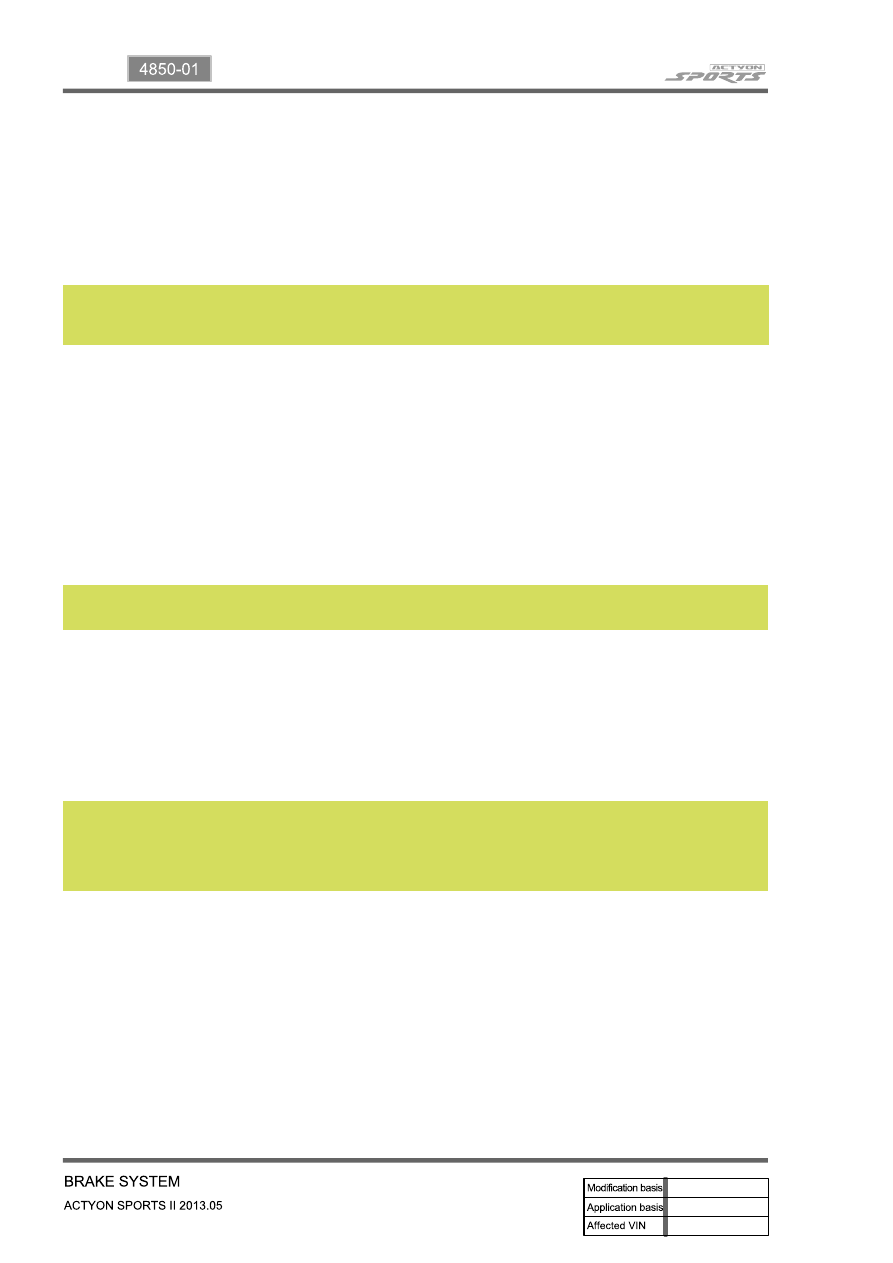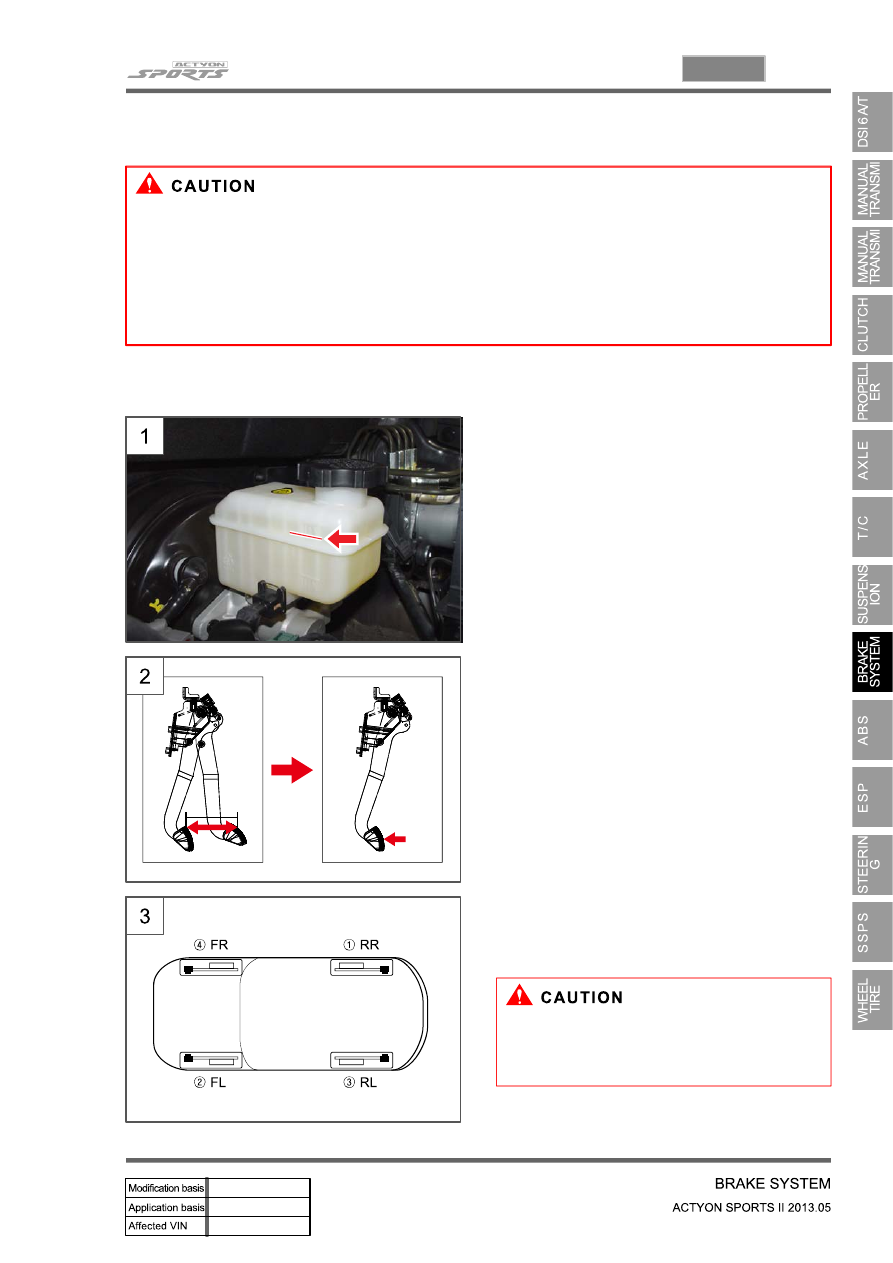SsangYong Actyon Sports II. Manual — part 140

09-8
Problem
Possible Cause
Action
Increased pedal stroke
Air in brake line
Bleed air
Oil leak
Repair
Worn brake pad
Replace
Excessive clearance between push rod and master
cylinder
Adjust
Worn or damaged piston seal
Replace
Brake dragging
Parking brake is not fully released
Release
Incorrect adjustment of parking brake
Adjust
Incorrectly adjusted clearance of parking brake shoe
Adjust
Faulty brake pedal return spring
Replace
Incorrectly adjusted free play of brake pedal
Adjust
Faulty master cylinder
Replace
Lack of lubrication in sliding parts
Lubricate
Faulty brake booster (vacuum leak)
Repair
Wear, hardening or poor contact of brake pad
Replace
Oil or water on lining
Repair or replace
Fixed or broken parking brake cable
Replace
Excessive stroke of brake lever
Adjust notch
Faulty auto clearance adjuster
Repair
Poor parking
brake
Increased stroke of
parking brake lever
Loosened parking brake cable
Adjust or replace
Incorrectly adjusted parking brake cable
Adjus
Defective automatic lining clearance adjuster
Repair or replace
Worn brake lining
Replace

09-9
4850-01
Problem
Cause
Action
Burning smell around
tire
Too frequent braking in high driving speed
Reduce the use of
foot brake/use
engine brake
properly
Used only foot brake during downhill driving
Driving with foot on brake pedal
Get off the foot from
pedal
Foreign materials such as dirt or sand in brake system
Replace: caliper,
wheel cylinder,
master cylinder,
return spring
Broken return spring in shoe assembly
Replace
Incorrectly adjusted parking brake cable
Adjust
Incorrect wheel or wheel cover
(generating the heat)
Replace

09-10
This section describes the noise phenomena occurred possibly in the brake system operation.
Distinguish between the information given below and the actual problems and then, inspect the vehicle
and take appropriate measures.
Noise symptoms and Causes
-
Symptom 1. If depressing the brake pedal when the engine is cold, "screeching" sound always
occurs and, after driving for a while, the sound disappears..
This usually occurs in the morning. When the temperature goes down, the dew condensation
phenomenon sets moisture on the brake disc as the window frost forms. Due to this moisture, the iron
within the brake disc and pad oxidizes, forming undetectable micro-rusts on the disc surface. When
starting the engine under this condition, noise may sound due to the friction of micro-rusts. When
operating the brake several times, the disc temperature goes up and the micro-rusts come off and the
noise goes away. Depending on the driving conditions, noise gets louder when slightly depressing the
brake pedal and oppositely, noise is smaller when deeply depressing the brake pedal. This is simply a
physical phenomenon, called "morning effect" in professional terms, and does not imply any problems
with the brake system.
Symptom 2. Slip or screech after the brake pad replacement.
This usually occurs when the bed-in is not made between the disc and the pad's friction material. The
bed-in is a state that the brake system normally works and gives no noise out, when, after about 300 km
city driving, the contact area of the pad friction material is enlarged and the disk is in complete contact
with the pad's friction material. Therefore, for some time after the brake disk/pad replacement, the brake
system poorly operates or noise (abnormal sound) occurs due to the partial contact.
Symptom 3. "Groaning" sound occurs in the automatic transmission vehicle when slightly taking the foot
off the brake pedal to slowly start after waiting for the signal, or slightly depressing the brake pedal.
This is the noise "Creep groan" that occurs when, in both the automatic and manual transmission,
slightly releasing the brake pedal in the neutral gear at downhill roads.
It frequently occurs at the low braking power and low speed, through the following process. When
operating the brake system at low speed and low pressure, adhesion and slip repeatedly take place
between the brake disk and the friction material, and this makes the braking power inconstant, instantly
increasing or decreasing, and gives out the brake noise.
It is also a physical phenomenon and has no relation with the brake performance.
BRAKE OPERATION AND NOISE
▶

09-11
4850-01
4. AIR BLEEDING
Fill up the brake fluid up to "MAX" line on the
reservoir.
1.
Fill the reservoir with brake fluid and pump the
brake pedal several times. Then keep it
depressed.
2.
Loosen the bleed screw and collect the
bleeding brake fluid from the brake line with
the order in the figure.
3.
Fill the reservoir with the brake fluid as much
as it bleeded, and continue to bleeding
operation.
Never reuse the used brake fluid.
Use only specifies brake fluid (DOT 4). Add brake fluid between MAX and MIN lines on the
reservoir (0.7 to 0.8 liters).
Be careful not to splash the brake fluid on painted area or body.
Make sure that any foreign material does not get into brake line.
Always work with another staff.
-
-
-
-
-

Нет комментариевНе стесняйтесь поделиться с нами вашим ценным мнением.
Текст